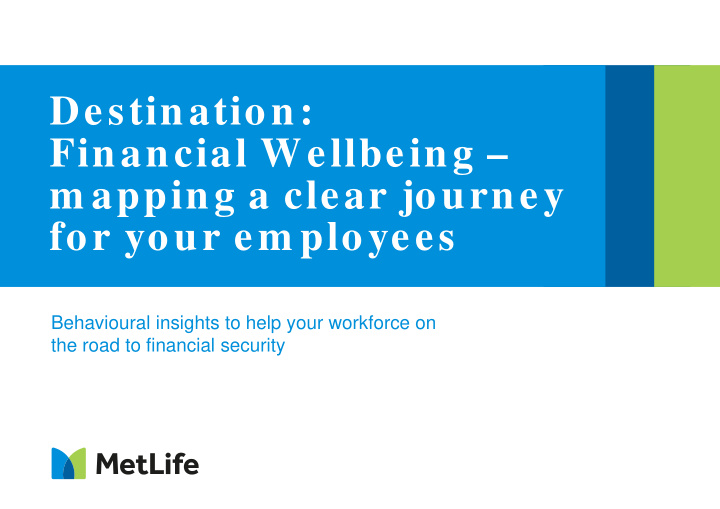



Destination: Financial Wellbeing – m apping a clear journey for your em ployees Behavioural insights to help your workforce on the road to financial security
What you need to know before planning your route to financial wellbeing For your employees, financial wellbeing isn’t a destination, it’s a journey. And like any journey, there are 36% often bumps along the way. of employees say they have been distracted at work due Behavioural science techniques are designed to make the to money worries* journey easier. And the results, for the individual and for your business, are more than worth it. 55% of employees place a high value on benefits provided by employers* * 2017 MetLife Employee Benefit Trends Study
So what is financial wellbeing? Financially well employees have: • Control of month-to-month finances. • Capacity to absorb a financial shock, such as a period without work. • Confidence that they’re going to meet financial goals. • Choices that allow them to enjoy life.
Plot your route Thankfully there are a few easy ways to help your employees navigate the route to financial wellbeing. Many of them are drawn from behavioural science, of which nudge theory is a big part. This idea is based on using small hints or ‘nudges’ to help people avoid their natural biases and make better choices.
Present bias, or prioritising short-term needs over long-term goals, is a common example. Behavioural science techniques work to correct these biases by being conscious of the way our minds work. Think of it like a compass, providing a gentle steer towards the positive action. TIP: Frequent, regular interventions are more effective* * 2017 MetLife Employee Benefit Trends Study
Here are a few exam ples: • Framing Loss is more motivating than reward.* For example, when it comes to retirement planning, focus on the losses that come from not engaging, instead of potential gains. • Pre-commitment Agreeing to something in advance makes us more likely to do it.** For example, workers are more likely to raise saving in line with future pay rises if they’re asked before they receive the raise. • Social norms Everyone wants to fit in. Messages like “85% of our employees participate in our financial wellness programme” can encourage further sign-ups.*** * Daniel Kahneman and Amos Tversky, “Prospect Theory: An Analysis of Decision under Risk”, Econometrica, 1979. ** Cass R Sunstein, “Nudging: A Very Short Guide”, Journal of Consumer Policy 37, no 4, 2014. *** Robert B Cialdini, Carl A Kallgren and Raymond R Reno, “A focus theory of normative conduct: A theoretical refinement and reevaluation of the role of norms in human behaviour”, Advances in Experimental Social Psychology 24, 1991.
Avoid getting off-track with poor com m unication Talking about personal finances can be difficult. To help employees prepare for a more secure financial future, this taboo needs to be challenged with clear and open communication. TIP: Personalising your programmes is key to creating an open dialogue and engaged employees.
Tips for com m unicating • Involvement Get employees involved in designing a financial wellbeing programme. That way, you’ll understand their needs while removing stigma around money talk. • Keep it visual Most of us are visual learners. We prefer to look at a picture rather than a wall of text. It’s the difference between a simple map and a page of directions. • Ask questions Ask employees to think about their level of financial concern and their own behaviours. Identifying the gap between ‘what is’ and ‘what ought to be’ is a good self-motivator.
Moving forward Having a financially well workforce is your business’ ticket to a more productive and profitable future. Research has found that improving financial wellbeing improves general health questionnaire scores, regardless of income level. That has a knock-on effect on mental health – which translates to better performance at work.
Even a small increase in financial wellbeing can add to the bottom line. Research has found that: • Organisations with highly engaged employees saw their share price rise 16%, compared to an industry average of 6%. * • Employers can expect £346 in positive job outcomes from each employee who slightly increases their financial wellbeing. ** • Engaged employees outperform disengaged employees by about 28%.*** * Serota Consulting, 2005. ** AHOPE Foundation, Why do business [sic] need coaching and employee financial education? *** John M Gibbons, Employee Engagement: A Review of Current Research and Its Implications, The Conference Board, 2006.
Get going To recap: • Financial stresses can hamper productivity. • Conscious financial planning is hindered by innate biases. • Using the tips you’ve learned in this Behavioural science is one way to presentation, you can start to help your address these biases. employees make better financial decisions, • Employees who are financially well and reduce their worries about money and help engaged are more productive and less them perform their jobs as best as they can. likely to leave. • Gaining a reputation as an employer that cares about its employees’ overall wellbeing can be effective in recruitment, retention and brand building.
Products and services are offered by MetLife Europe d.a.c. which is an affiliate of MetLife, Inc. and operates under the “MetLife” brand. MetLife Europe d.a.c. is a private company limited by shares and is registered in Ireland under company number 415123. Registered office at 20 on Hatch, Lower Hatch Street, Dublin 2, Ireland. UK branch office at One Canada Square, Canary Wharf, London E14 5AA. Branch registration number: BR008866. MetLife Europe d.a.c. (trading as MetLife) is authorised by the Central Bank of Ireland and subject to limited regulation by the Financial Conduct Authority and Prudential Regulation Authority. Details about the extent of our regulation by the Financial Conduct Authority and Prudential Regulation Authority are available from us on request. www.metlife.co.uk 2493.1.APR18
Recommend
More recommend